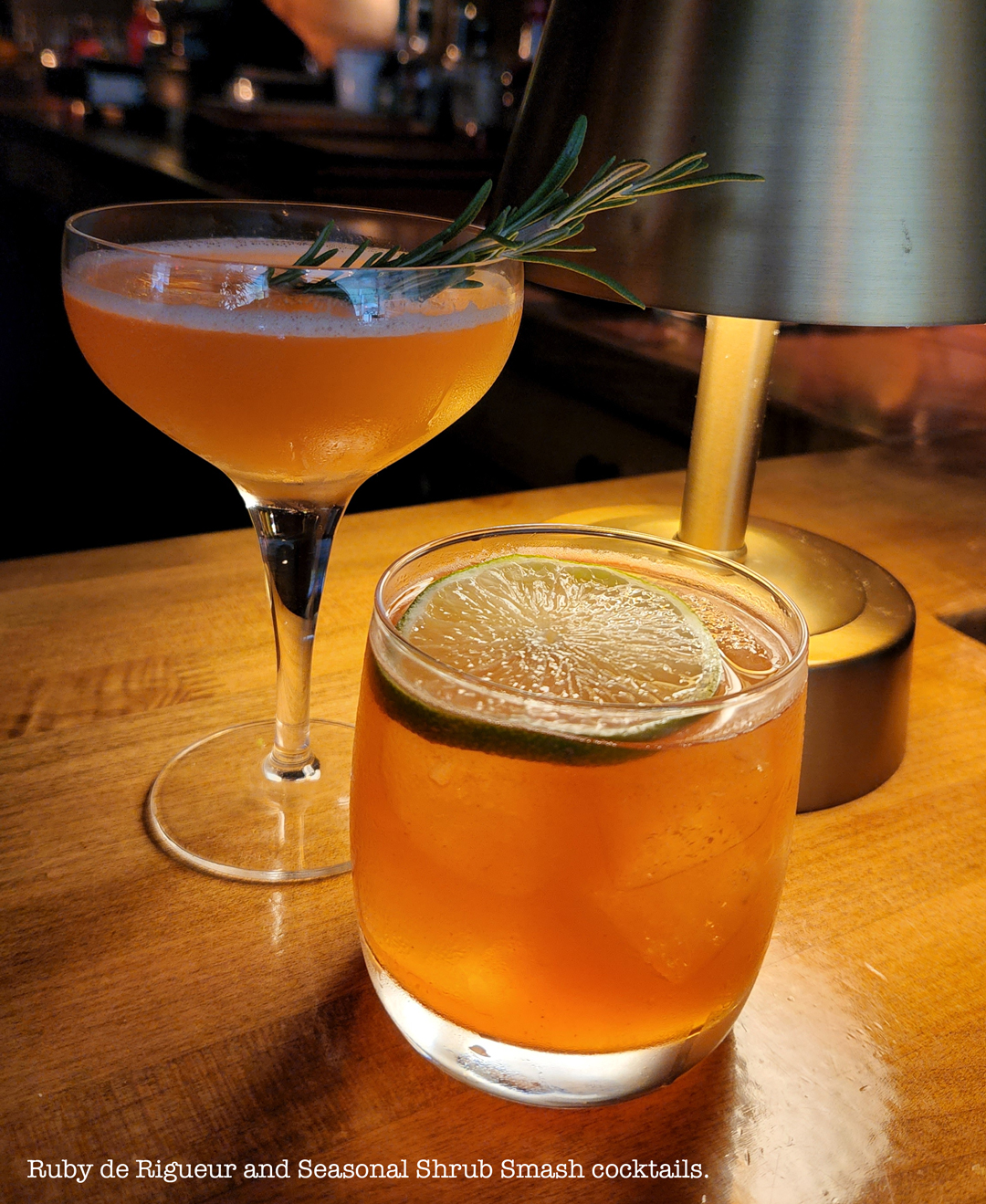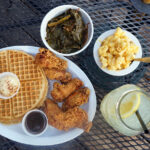
I literally sigh as I step onto Radish & Rye’s elegant patio. Almost instantly, a lush canopy of trees begins to thaw the tension of an hour spent maneuvering Albuquerque’s rush-hour traffic roulette, the crawl of interstate construction, and the thunderstorms roiling overhead. Midway through settling in at a shaded table with Sokhang Pan for a brisk and bouncy conversation about his bar program, I’ve forgotten all about the stressful drive that brought me to this oasis in Santa Fe.
The son of Southeast Asian refugees who arrived in the United States in 1985 and a first-generation American, Sokhang grew up moving frequently between the neighborhoods of Long Beach and South Central Los Angeles. In adolescence, he began learning the art and skills of a barista, absorbing everything he could about coffee culture before expanding into home brewing kombucha and eventually beer. That transient youth prepared him for the nomadic lifestyle of his twenties as he moved from one national park to the next, opening lodges and training restaurant teams for the concessions industries in the park system.
“Working in food services, working with coffee, home brewing, and then working at a wine bar was when I realized, ‘Oh, this is awesome!’ My family has a noodle shop in Thailand, my cousin is a Michelin star chef; it’s just always run in the family. Food has always been around me and being a child of immigrants, learning about food and understanding food is a way to learn about culture.”
That love of food and the expression of culture contained within regional ingredients is what drove Sokhang to delve deep into the growers’ community here in New Mexico, searching for the best, freshest ingredients to feature in his cocktails. “Everywhere I’ve lived, I’ve always been inspired by whatever is happening regionally. I think it says a lot about the people that live in that area, and it allows me to participate and really get to know the people and how they decide to eat and drink.”

As the chill of the overcast evening sets in, we move inside to the bar. The restaurant is aglow with countless tiny candles, throwing inviting pools of flickering light against gleaming wood surfaces. The space is open and airy, yet cleanly defined by structural supports of steel and concrete offset by aged whiskey barrels and seasonal flower arrangements. I slip onto my stool, feeling as though I’ve stepped into a thoroughly modern yet incredibly cozy haven.
Sokhang prepares two cocktails for me to sample. The first drink, the Ruby de Rigueur, arrives in a coupe glass with a simple sprig of fresh local rosemary. The drink is whiskey forward, with honey and ginger adding sweet, zesty notes to the mellow smoothness of the spirit. A hint of rosemary lingers, lending an herbal quality to the finish. The second offering, the Seasonal Shrub Smash, is the epitome of summer. Bright watermelon flavors burst forth, countered perfectly with a kick of warmth from the shrub’s infusion of guajillo chile (and the whiskey). Minty coolness settles in just as the vinegar tang takes hold. The drink is complex and fun, but the concept of a shrub is new to me, so I ask for a crash course. “A shrub is a drinking vinegar,” he explains. “It’s an old way to preserve fruit that has already ripened. What’s exciting about working here is that we’re a farm-to-table concept, and we know all of our farmers by name. I’ll call and ask ‘Hey, what fruit looks good right now?’ and then I’ll pick up a case and make a drinking vinegar with it.” Shrubs, says Sokhang, start with ripe fruit, sugar, herbs, and spices, which sit for forty-eight to seventy-two hours, until the flavor is developed to the taster’s preference. Then, vinegar is added to preserve the fruit and give the shrub a lengthy shelf life. From there, the vinegar becomes part of the mixology magic behind the bar—in this case, as a key component of the whisky smash.

At this point, I realize that if I’m going to continue sampling drinks, I’d better order some food. The restaurant’s motto is “farm inspired cuisine with a Southern sensibility,” and the typically Southern dishes I settle on—kicked up several notches by their decidedly Southwestern ingredients—meld perfectly with the crooning voices of Patsy Cline and Marty Robbins. The corn fritters are smooth, creamy orbs of Tucumcari cheddar fried to lightly spiced, crispy perfection and served alongside plump corn kernels in a cheese sauce (did I detect feta in there?) studded with fresh, multicolored garden tomatoes. Rounding out the appetizer is a cool, herbed goddess dip. The fried green tomatoes come as two thick, delicately battered disks, lightly fried and set atop zippy balls of pimento cheese. An airy tangle of red chile thread finishes the dish.
“My chef [Dru Ruebush], who runs the culinary program, is also inspired by regional cuisine,” Sokhang says. “He’ll take a recipe from his grandma, who lived in the South, and sort of elevate it. He’s from Silver City, so he’s drawing inspiration from New Mexican cuisine and from Southern cuisines as well.”

As I settle in with my dishes, the aroma of pipe tobacco suddenly fills the air. It’s a heady, earthy scent, and heads swivel to find the source. Behind the bar, Sokhang smiles shyly, cognizant of the effect his activity is having on the patrons. Before him stands a tall glass cylinder, smoke churning in its confines, with a cocktail glass perched above to contain the plumes. I half expect a length of old, oiled leather to unfurl across the bar as I’m transported to a stately drawing room in a Mexican hacienda of the early 1900s. This amazing creation goes by the name Abuelito, and it is one of Radish & Rye’s flagship cocktails.
“In a decanter we build a traditional manhattan with 2:1:2 metrics,” he explains. “That’s two ounces of whiskey, one ounce of vermouth, and two dashes of bitters. Then we smoke the decanter with pipe tobacco that we get from Primo Cigar Shop & Lounge just a couple of blocks away from the restaurant.” I could die in this drink. The flavors of mellow whiskey infused with smoked tobacco envelop the tongue, with just the slightest hint of complex bitters underlining the musky flavor. It’s all I can do to set it aside to sample my fourth and final drink, the Goldfinch Blanc Sour, which, Sokhang laughingly assures me, will be worth abandoning my black-and-white película fantasy for. He’s not wrong.

Rolling out in a coupe glass, crowned with a thick crema of thoroughly shaken egg white and adorned with an artistic arc of bitters, this drink sports the classic look of a Ramos gin fizz as crafted by a barista. Sokhang’s early days in the world of coffee are on parade with his presentation, and it’s a deceptively simple masterpiece. Breaking through the egg cream, the drink lands on the tongue in an explosion of sour citrus and earthy whiskey. The texture is silky yet dense—ropy, if I recall my vintage recipe for the famed gin fizz correctly—and I immediately understand his explanation of textures in cocktails. “We’re reaching a point where bartenders are no longer just considering flavor palates and dishing things out quickly. There are more steps in curating drinks now and people are considering texture, viscosity, and weight—all kinds of things.”
Sokhang’s humor and humility shine through when he speaks of his journey to Radish & Rye. “It’s for the discerning and the confused. And the apprehensive!” he jokes, adding, “I would say that Radish & Rye is exactly there, where it’s accessible to everyone, but then there is a lot of care and craft that comes in on the dinner menu and the cocktail menu.” More serious yet, he says, “I wouldn’t be who I am without all of the inspiration and help that I’ve gotten along the way, and I’m grateful for everyone that has helped me. I’m grateful to Dru [Ruebush] and Camille [Bremer], my employers, for the opportunity to work in such an excellent bar program here.”
Sokhang’s love for his craft is evident in the way his face lights up as he speaks of his process, the animation in his gestures as he describes his work, and in every sip of his carefully curated cocktails. As I savor the last of my Goldfinch, the last of the daylight has faded and Santa Fe is shrouded in darkness. Yet all around me in this beautiful space, those tiny pools of firelight illuminate the faces of patrons from all walks of life. I feel a tiny pang of sadness as I rise, hesitant to leave. Sokhang turns, a smile on his face, and offers his hand in effusive thanks. His joy is infectious, and I know without a doubt that I’ll return sooner rather than later.


Raven Del Rio
Raven Del Rio bounced around the country before falling in love with New Mexico fifteen years ago. A former writer for La Loca Magazine, she's happiest when roaming the highways and byways collecting stories to share. When she's not on the road, she can usually be found working on a vintage Coachmen camper or running with her German Shepherd, Ziggy.







